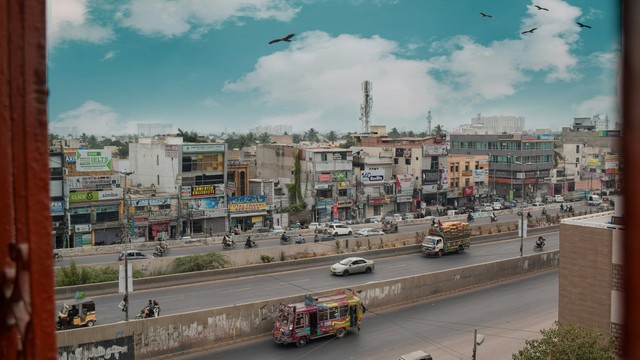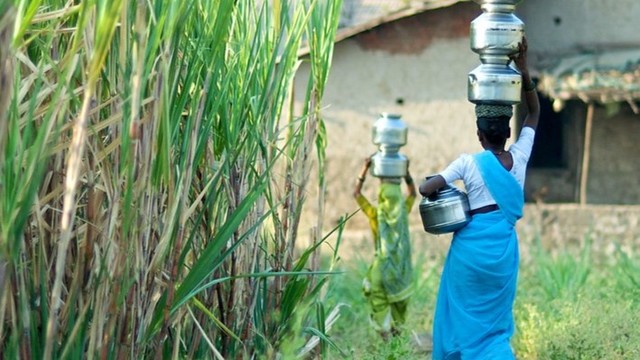How India's slum and pavement dwellers made sanitation affordable
In India, slum and pavement dwellers' organisations have designed and managed a programme of community toilets and washing facilities that are used by hundreds of thousands of households. Guest blogger Sheela Patel describes how this was achieved.


Ongoing monitoring of communal toilets has helped to improve design: here, smaller toilets for children are included in adult toilet blocks. Previously children's facilities were in separate buildings and were frequently left uncleaned (Photo: SPARC)
While the Millennium Development Goals brought attention to the sanitation challenges in cities, it is now evident that the 2015 target for sanitation will not be achieved in many urban areas. Yet in many cities, locally-driven initiatives, involving slum dwellers and grassroots groups, demonstrate that progress can be made.
Today, hundreds of thousands of slum dwellers in India have community toilets and washing facilities, designed and managed by slum dweller organisations. They very often built them too. The capital costs were mostly funded by local government, with community contributions covering operation and maintenance.
In addition, slum dweller organisations have been able to build on their work with city governments on this to address other pressing issues.
From a single toilet block…
In 1993, a savings group formed by women who lived on the pavements in central Mumbai persuaded the city authorities to let them build a community toilet. Once permission was obtained and funding secured, the building with four pour-flush latrines, a water tank and a room for the caretaker was finished in a few weeks.
From this one example, much visited by other women's savings group, a new model of toilet blocks developed – designed and managed and often constructed by women's savings groups.
…to hundreds of toilet blocks
Since 1993, 366 toilets blocks with 6,952 toilets serving more than 350,000 people have been built in Mumbai, thanks to the federation of slum and pavement dweller women savers (Mahila Milan) with support from the National Slum Dwellers Federation and a local non-governmental organisation, the Society for the Promotion of Area Resource Centers (SPARC).
Similar toilet blocks have been built in many other cities, including large numbers in Pune and in many of the municipalities surrounding Mumbai.
But expanding this model also meant having to work in communities without women's savings groups to manage the facilities – and having to cope with political interference (politicians are used to influencing contracts to build toilets and are often hostile to the federations). Local government officials at ward level often did not want to work with slum organisations
Making community toilets work
Providing sanitation involves more than just building the toilet block, although even that is complicated. The management and treatment of the faecal matter is equally challenging and there is a need to make sure defecation occurs in toilets, not in the open. Some of these aspects can be tackled by communities with no sanitation, while other aspects have to be done by the city.
It is not easy to build a community toilet block. Building a block with ten seats for women and ten for men costs around US$50,000. Land has to be found and its use for the toilet block agreed by residents and approved by government. Detailed surveys, designs and costings have to be made in each location. Land availability is often so constrained that the blocks have to be two or three storeys high. Contracts are required.
For slum dwellers to become contractors for government-funded toilet blocks is complicated and risky. They need to be registered and to open a bank account – and banks have no procedures for collective accounts owned by slum dweller women.
They need to have enough money to be able to cover the costs of the construction until the government money starts coming in – and this is often very slow.
Running and maintaining a toilet block is also challenging. They are used intensively and so need intensive cleaning and maintenance. Water and electricity bills need to be paid. Funding has to be generated from users, but toilet use has to be cheap enough for very low income groups to be able to afford it several times a day.
This means special arrangements – such as family passes for local residents. A caretaker has to be appointed who really does keep the toilets clean – and the organisation must be set up for careful and transparent financial management.
Just as importantly, all of the women, men and children must want to use the toilet (and not defecate in open spaces) so access must be quick and queues must be kept down. The community toilets charge local households just $1-2 per month, which must make them among the cheapest sanitation anywhere.
Beyond sanitation
But there is a bigger story than this. The two federations and SPARC always saw this work on sanitation as a way to engage more constructively with local government. The need for toilets is so obvious and a community toilet can be provided without addressing more complex issues such as the residents' right to live there.
No large-scale programme is possible without government support. At first, this support was simply for getting toilet blocks built as quickly as possible (before the senior civil servants whose support is needed move on elsewhere).
Initially, local government assumed that communities or NGOs would manage and maintain the new toilet blocks. But many maintenance issues need support from local government – for instance irregular water supplies or electricity services or provision for disposing of toilet wastes (much easier and cheaper if there is connection to a sewer).
In Mumbai, with the support of the Additional Municipal Commissioner, a new system has been set up to monitor the functioning of all toilet blocks, to identify problems and to establish or strengthen relations between ward officials and those managing local toilet blocks. This monitoring system and the regular meetings between local government staff and the federations also produced solutions to the maintenance issues.
Working towards city-wide coverage is only possible if local governments actively engage with residents. This shows local government staff what valuable allies community organisations can be. It also lays the ground for engagement on other issues such as schools and healthcare.
The most valuable outcome of a good sanitation project is a good working relationship between the community organisation managing it and local government – which provides an example to other communities of how this can work.
Complicated as it is, building a toilet is the easy bit – making it work, organising the community to partner with the city authorities is the difficult bit.
Sheela Patel (sparcssns@gmail.com) is founder and director of SPARC, a Mumbai-based NGO that has worked with and supported the work of Mahila Milan (a federation of savings groups formed by women living in slums or on the pavements) and the National Slum Dwellers' Federation. She is also chair of the board of Slum/Shack Dwellers International, a network of community-based organisations of the urban poor in 33 countries in Africa, Asia, and Latin America.
Further resources
This blog is drawn from a paper in the April 2015 issue of Environment and Urbanization on sanitation and drainage in cities. Full access to this paper is free until July and the editorial for this April 2015 issue has a summary of all the papers.



